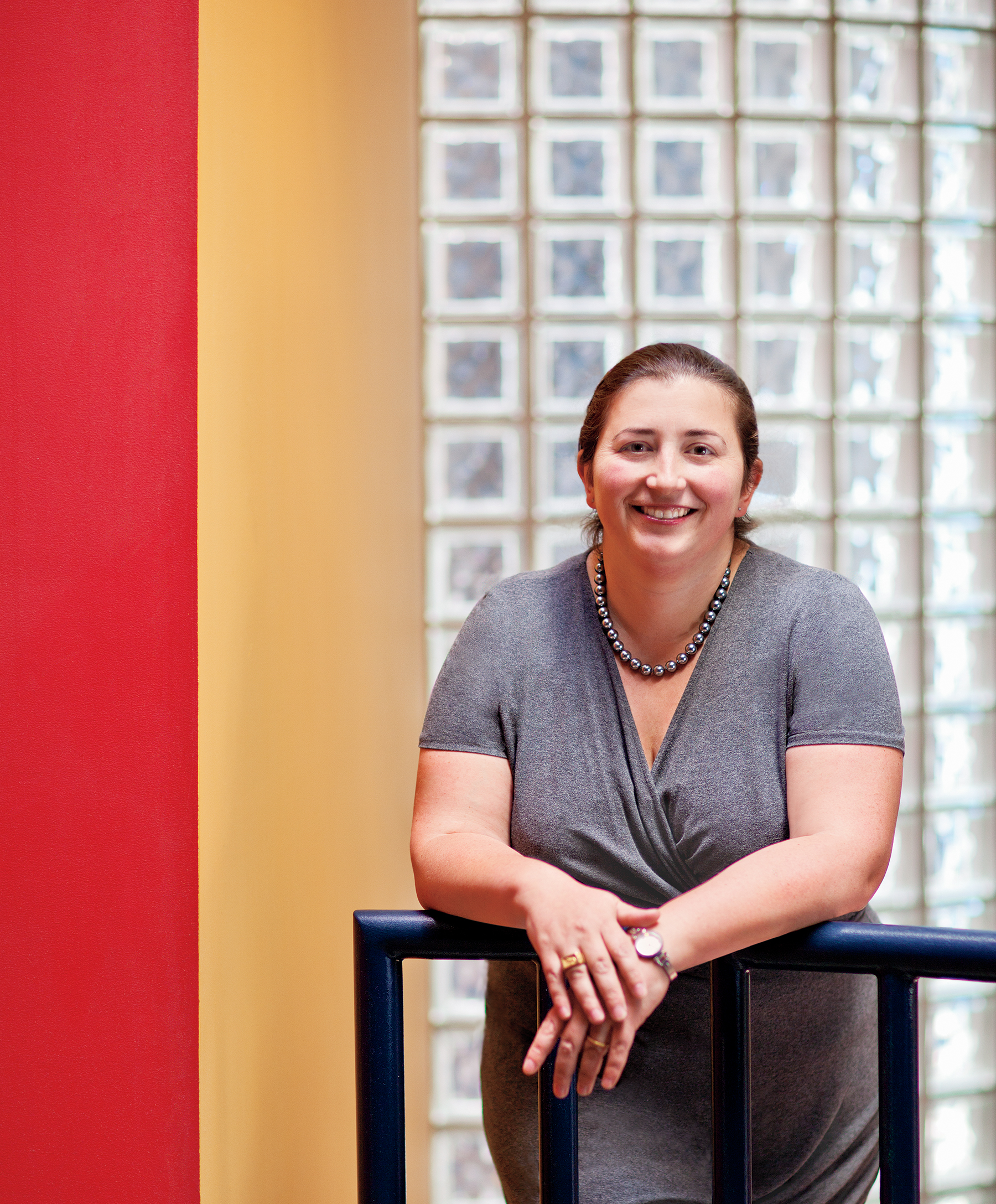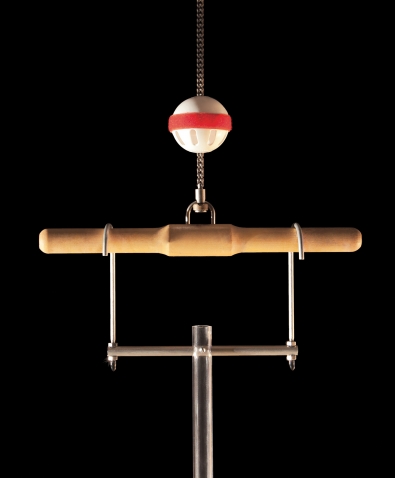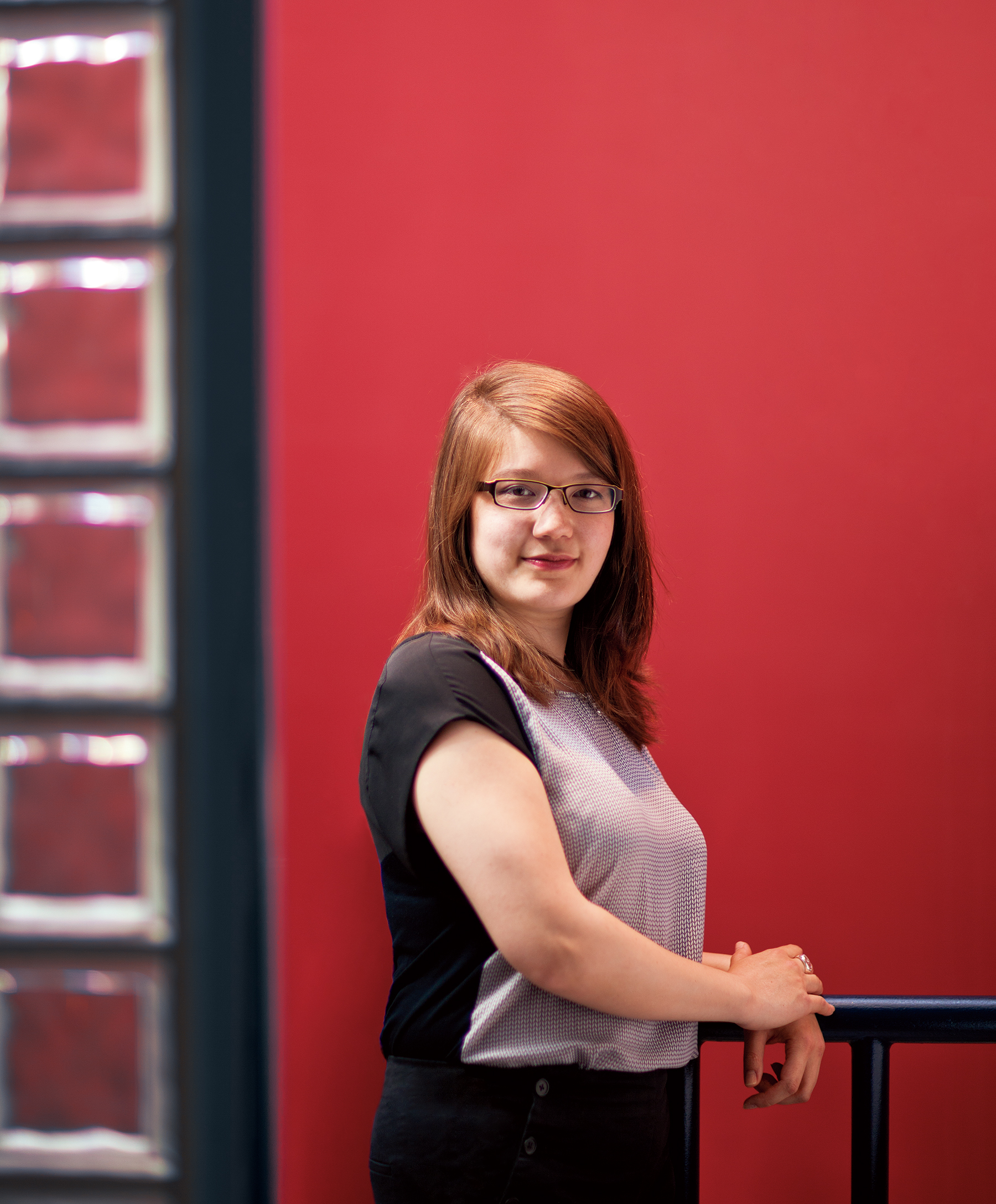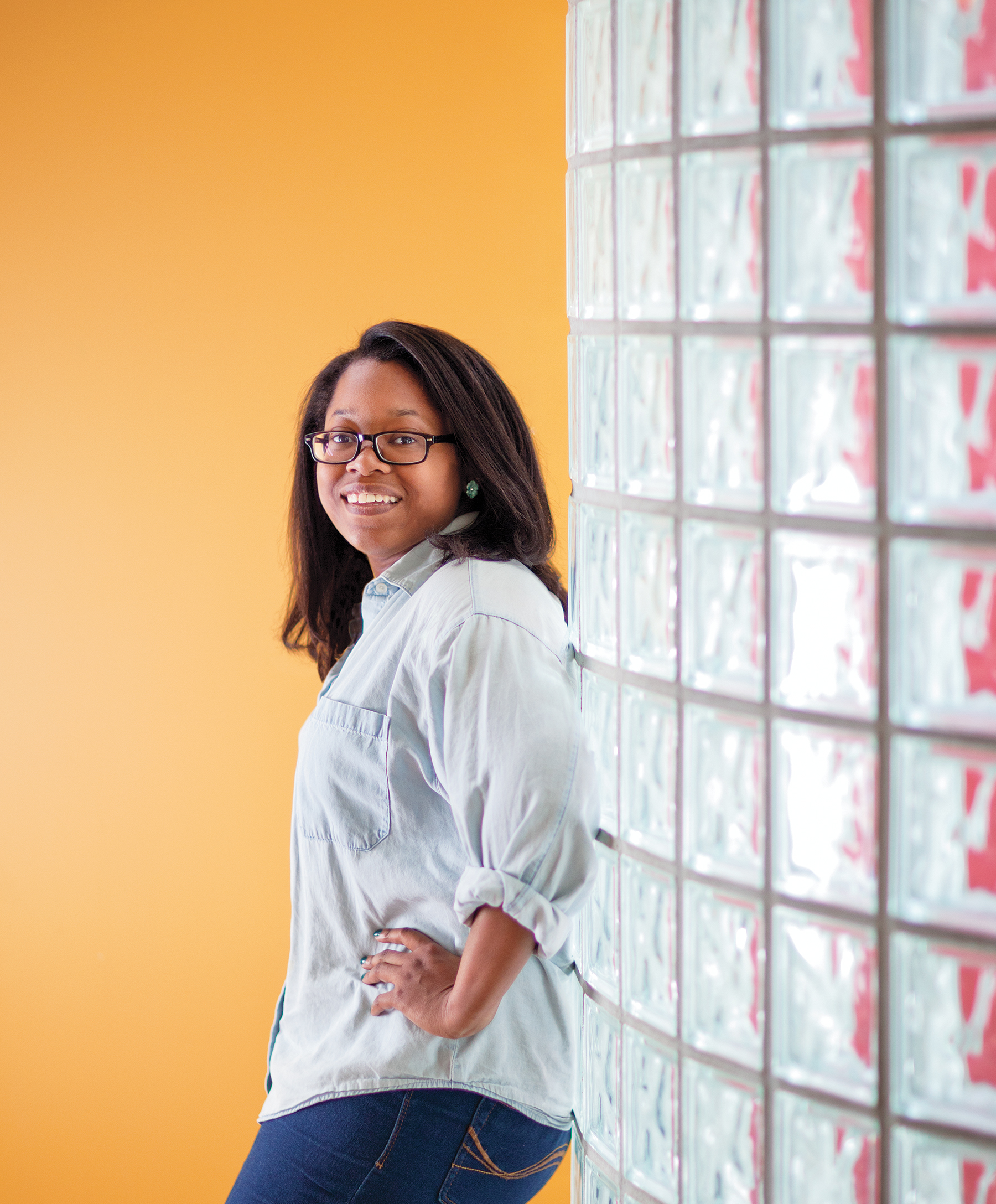The spring of her sophomore year, buzzing with that special kind of excitement that comes from having wielded power tools, Elena Shaw ’15 hurried to Shakespeare House with her creation—a bottle opener. “I was like, ‘Guys, I can open bottles. Let me show you,’” as she used her tool to pop top after top, to applause from her fellow Shakers.
She made the opener as part of ENGR 160, Fundamentals of Engineering, one of the courses offered by the new Wellesley Engineering Laboratory (We-Lab); the assignment required that the openers be made out of one single piece of material. “I remember thinking, ‘Well, this is so easy. I would rather do something more interesting with it.’ So my partner and I both decided that we wanted to create something that was more aesthetically pleasing,” Shaw remembers. In the end, they designed the opener to look like an owl; you put two fingers through its eyes, and opened the bottle using a hole in its body. It was very cute.
“The problem was that we didn’t put too much thought into the actual utility of it,” Shaw says. The bottle-opening session at Shakes caused the device to chip a little bit, and when it came time to be tested in class, it failed spectacularly. “Of the entire class, ours was the only one that did not succeed in the first two times,” Shaw says. “That was my biggest failure of that class. So it was good it came first.”

Amy Banzaert, director of We-Lab
The normalization of failure is one of the things that really drew Shaw to engineering. “Being in a space where I was not only allowed to but encouraged to make mistakes—and not only to make mistakes, but to make them as quick as possible so that you can create the craziest ideas, and maybe those will be the best ones—that idea really spoke to me,” Shaw says.
The We-Lab, which offers three introductory courses and an engineering seminar series, encourages students to embrace the messiness that comes with solving real-life problems, says its director, Amy Banzaert. “One of the things students learn in my classes is that real things have real limitations. … And in engineering labs, you’re expected to hit your head against those real limitations,” she says.
Another core part of the We-Lab is emphasizing the role of technology as a humanitarian endeavor, addressing needs of underserved populations internationally and locally. For example, in ENGR 111, Product Creation for All, the students build tools for Community Rowing, a nonprofit in Brighton, Mass., that helps people with physical disabilities get on the water.
“It can be kind of dull to learn a beam-bending equation, but when that beam will either support or not support a person who rides a wheelchair who’s using it to transfer from their wheelchair to a scull to start rowing, all of a sudden, beam bending is really interesting,” Banzaert says. “It allows us to see the application of this knowledge directly, think about the big picture, and do some service, which really matches the Wellesley mission.”
Bringing Engineering to Wellesley
Until relatively recently, Wellesley students who wanted to study engineering would take classes at MIT or wait until grad school. But in 2006, a group of Wellesley faculty created an experimental engineering Wintersession course at the College, with the help of two professors from the newly founded Olin College of Engineering, a few miles away in Needham. Soon after, an engineering course was added to the academic-year curriculum. A grant from Wellesley’s Davis Education Foundation and support from the administration allowed for the creation of what is now the We-Lab, a dedicated engineering space that includes a 3-D printer and a laser cutter. But as there was no dedicated engineering faculty member, the course was taught by faculty from Wellesley, Olin, and other institutions, depending on who was available.
‘Engineering is pretty male-dominated, and I still get chills some days, just being surrounded by women working on these amazing problems.’
—Amy Banzaert, director of We-Lab
But it was obvious that a full-time engineering faculty member was needed, and in 2012, the College began a search. “So [Wellesley] posted it, and like 10 people at MIT emailed me, saying, ‘This is the position for you,’” Banzaert says. “It matched me very well, and I was so thrilled to find it.”
Banzaert studied mechanical engineering as an undergraduate at MIT and then worked for several years at Texas Instruments before returning to MIT as its first service-learning coordinator. “I was getting to inject really solid, service-learning-oriented projects into core curricular materials,” she says.
However, Banzaert missed participating in research, and so she started pursuing her master’s and Ph.D. at MIT. Her research focused on two areas: service learning as a pedagogy, and alternative cooking fuels for developing countries. She did her research in collaboration with MIT’s D-Lab, a program that fosters the creation of appropriate technologies and sustainable solutions for developing countries. (It’s not a coincidence that D-Lab and We-Lab rhyme.)
But although their names and missions are very similar, Banzaert says the We-Lab has its own vibe. “The thing that still strikes me—this is my third year here, but it’s still noticeable—is that my classes are all women. Engineering is pretty male-dominated, and I still get chills some days, just being surrounded by women working on these amazing problems,” she says. She has also found that when she asks her students to reflect on the needs of the end user, instead of just focusing on what they think will be a cool bit of tech, Wellesley students embrace that challenge in a way that she rarely experienced at MIT.
Wellesley students also tend to bring their background in other disciplines into the We-Lab, which Banzaert enjoys. “I was asking students what they thought feedback control might be, when we were first introducing the topic. And a student was like, ‘Well, it’s kind of like government, with the checks and balances.’ And I had never even related those two things in any way,” she says. “To have that happen in my class was so cool.”

One semester, the theme of Fundamentals of Engineering was “follow the light.” Two students made this LED lamp that turns on and off and moves in response to changes in light.
The Hard-Core Engineers
For students like Elena Shaw, who take an intro course and get hooked, there are options for diving deeper into engineering. Shaw, for example, spent a summer working with Banzaert on her cookstove research. At MIT, Banzaert had helped develop a charcoal briquette made from agricultural waste, which burns far cleaner than plain wood. “We make charcoal from ag waste that’s already available, that’s currently rotting and making methane, which is a problematic greenhouse gas. If we could partially burn it and turn it into charcoal briquettes for cooking, that would be an environmental win, a health win, and ideally an economic win, if you can make a microenterprise selling this cooking fuel,” says Banzaert.
For her summer-research project, Shaw tried to develop a method to measure the CO2 emissions that come off cookstoves. Outside the Science Center, Shaw set up a little canopy tent to simulate a house, with windows and a chimney. She would rig the “house” with instruments to measure CO2, fire up a butane gas stove, and run out of the tent, hoping that the instruments got good data … which, unfortunately, most of the time, they did not. “The research that we were doing over the summer, it was really challenging and did not lead to clean outcomes at all,” says Banzaert. “I was impressed by her ability to roll with the punches of real research. Sometimes you get clean answers, and sometimes you just get a mess, and we ended up with very messy data. And she was able to cope with that.”
‘I have had conversations with many of my friends who are dabbling in engineering or the sciences, and they don’t feel as if they would have chosen this same path if they hadn’t been at Wellesley.’
—Elena Shaw ’15
Not only was Shaw able to cope with it, but she was hungry for more. She is now pursuing the Olin-Wellesley 4+1 program, which enables Wellesley students who are accepted to the program to earn a B.A. from Wellesley in four years, followed by a B.S. from Olin College at the end of the fifth year. Shaw, who is majoring in physics, is focusing on computational engineering, a relatively new field that uses computational models and simulations to solve physical problems in engineering. Computer programming gave her some difficulties at first. “I was like, Elena, this is one of the things in life that you’re just not going to be good at, so you have to work hard at it,” she says. But after fighting her way through a 200-level course at Olin, she says, “Now that I’ve overcome those hurdles, I feel as if I’m so much more powerful.”
After finishing the program, Shaw hopes to work in “computational engineering/statistics. It’s a growing field. … It’s people who deal with big data, artificial intelligence,” she says. Shaw says that one of the biggest advantages of studying engineering at Wellesley is that it upends the assumption that only white men belong in the field.
“I have had conversations with many of my friends who are dabbling in engineering or the sciences, and they don’t feel as if they would have chosen this same path if they hadn’t been at Wellesley,” she says. “The faculty members are aware of the potential mental and psychological blocks that we have. I remember talking to one of my math professors and saying, ‘I would love to do physics research, but I don’t feel like I’m smart enough.’ And before I even said another word, he immediately stopped me and said, ‘Elena, if you want to do something, you can do it.’”

Two students in Fundamentals of Engineering programmed this robot, which they named Cerberus, to go through a maze using ultrasound. The robot was part of an exhibit that taught participants about how ultrasound works.
For Christina Holman ’17, the We-Lab was one of the reasons she decided to come to Wellesley. She took ENGR 111, Product Creation for All, her first semester at Wellesley and made a device for Community Rowing that makes it easier to attach stabilizing pontoons to rigs. She remembers showing her prototype to Community Rowing and Wellesley professors at the end of the course, and being thrilled when she was told her product was patentable. “[I was] a first-year, and I made a product that’s actually patentable and useable. It was this great feeling,” she remembers.
Like Shaw, Holman is taking part in the Olin-Wellesley 4+1 program, with a focus on electrical engineering. “To me, it’s like a game. It’s like [the computer game] Snake, you know? You have this current that’s flowing through it, and you have to make this path to get to this point. How do you make it so that it never hits itself, it never runs over something, it never fuses and jumps up? … That’s what draws me to it, that kind of complexity and beauty.”
Holman’s interest in electrical engineering was sparked in ENGR 160, Fundamentals of Engineering. She and her partner made the Wellesley Energy Bike, which a user pedals to power incandescent bulbs, fluorescent bulbs, or even a hair dryer, which are attached to a nearby display board. “Essentially, I got that engineering lifestyle,” says Holman. She and her partner worked from 3 p.m. to 3 a.m. the day before exhibiting the bike. “I’m pretty sure I shocked myself several times,” she says. “But when it was done, we looked at this red board we had taped to the back of this thing, and we were like, this is amazingly simple. … It’s a wonderfully elaborate, functioning bike-powered generator. … But when you look at the back of the board, it’s so simple.”
The Casual Engineers
For many students, the class they take in the We-Lab will be the one time in their lives they’ll get up close and personal with a laser cutter or a 3-D printer. And that’s just fine with Banzaert. She hopes that her classes help students broaden their perspective and gain some habits of mind of how engineers think, which they can take to their own disciplines.
“Many disciplines these days are going to be interacting with engineers at some level, and I firmly believe that people from liberal-arts disciplines who are willing to communicate with engineers are going to have a much deeper impact on the world,” says Banzaert. “The world’s biggest problems are going to be solved by very interdisciplinary teams. Those teams are going to be better if the liberal-arts majors are able to understand a bit of engineering and vice versa.”
‘[I was] a first-year, and I made a product that’s actually patentable and useable. It was this great feeling.’
—Christina Holman ’17
For Nicole Chui ’15 and Amanda Hui ’15, Product Creation for All has been a chance to take a class together (they’ve been friends since their fathers hit it off at Wellesley’s first-year orientation for international students), and to explore a subject outside their majors. Hui, who is double-majoring in economics and psychology, says that most of her classes have the traditional course work of problem sets, midterms, and final papers. But in the We-Lab, she and Chui were working to create an unsinkable foam pontoon for Community Rowers. “It’s cool that we didn’t know what to expect,” says Hui. “There were multiple times when we thought it wouldn’t work at all.” Chui, an architecture and German double major, enjoyed the open-ended nature of the project. “This is the most freedom I’ve ever had in a class,” she says.
There were a lot of dead ends and false starts over the course of the semester. They were planning on 3-D scanning an existing pontoon, but its shiny surface foiled the scanner. The pour-and-mix foam they bought only partially filled their 3-D-printed mold, so they needed to make adjustments to the mold. They wanted to make a full-scale mold for their pontoon, but they learned that it would cost several thousand dollars to make it. So instead, they made a smaller-scale model. But they managed to stay afloat, so to speak, and were excited to show their prototype to Community Rowing at the end of the semester.
Banzaert loves the moment at the end of the semester when the students present their projects. “Seeing students actually complete a prototype and get from their vision—with many changes, of course—to the final version and see an actual working product that they made with their two hands and their brain is fantastic,” she says. And the students wholeheartedly agree … no matter how many twists and turns and late nights it takes to bring that prototype into the world.
Wellesley’s Engineering Curriculum
ENGR 111, Product Creation for All
A hands-on seminar that explores how products are created, including an exploration of ideation and brainstorming, reverse engineering, and the product-development process. An emphasis is placed on the role of human-factors engineering, including usability successes and failures of specific products. Students learn about these topics through disassembly and study of existing products and creation of simple product prototypes for local nonprofit organizations serving populations such as those with developmental or physical limitations.
ENGR 120, Making a Difference Through Engineering
A project-based exploration of the technical challenges facing underserved communities in developing countries and locally. Technologies are focused primarily at the household level, exploring the benefits and limitations of existing and proposed solutions. Students learn and apply engineering design skills—including estimation, prototyping, and creativity—to address real problems facing community partners affiliated with the class. Specific themes for the class include energy, health, and transportation.
ENGR 125, Making a Difference Through Engineering—Fieldwork
Taught every other year, this course is a Wintersession trip. In January 2016, it will be taught in Nicaragua.
ENGR 160, Fundamentals of Engineering
This project-based course introduces the big ideas of engineering and prepares students for taking additional engineering courses at Olin College or MIT. Topics include: the design and construction of mechanisms using rapid prototyping tools such as laser cutters, 3-D printers, and computer-aided design software (SolidWorks); modeling and controlling physical systems using the MATLAB and Simulink programming environments; and feedback and control using digital electronics (microcontrollers).
Lisa Scanlon Mogolov ’99 is a senior associate editor at Wellesley magazine.












We ask that those who engage in Wellesley magazine's online community act with honesty, integrity, and respect. (Remember the honor code, alums?) We reserve the right to remove comments by impersonators or comments that are not civil and relevant to the subject at hand. By posting here, you are permitting Wellesley magazine to edit and republish your comment in all media. Please remember that all posts are public.